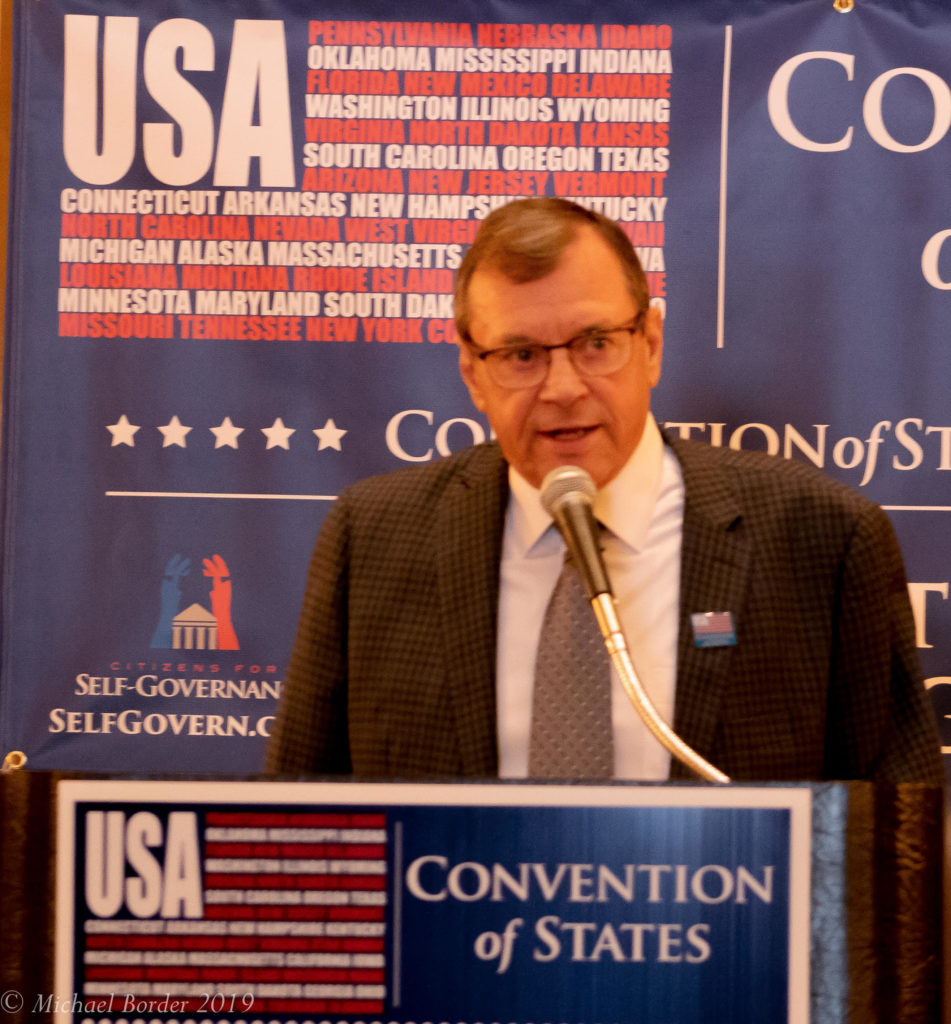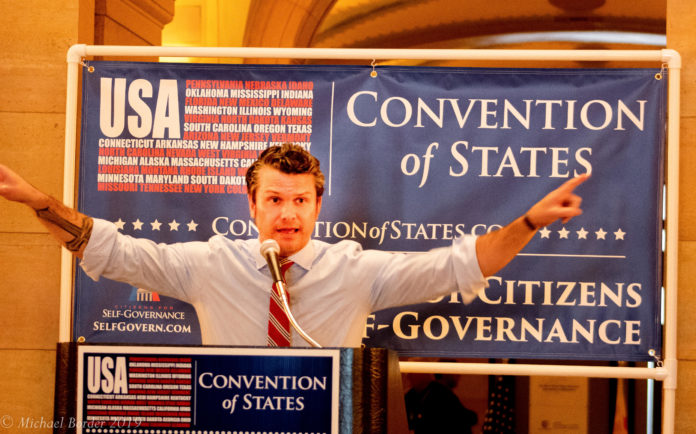The federal debt balloons to $22 Trillion and beyond. The federal government increasingly intrudes on state domains in bold power grabs. Unelected career bureaucrats and elected officials who have been ensconced in office for decades consistently fail to make meaningful headway on a to-do list of unresolved issues that grows longer and more costly each year.
Can concerned citizens do anything to help bring into check these formidable challenges?
Minnesota citizen Steve Davidson has found an answer considerately tucked into the Articles of the U.S. Constitution. The Founding Fathers foresaw the risk of a federal government taking excessive power unto itself at the expense of the states, Davidson explained. Lead by Colonel George Mason, the Framers unanimously adopted Article V of the U.S. Constitution to restore power to the people by giving the people and state legislatures the ability to modify distinct portions the standing Constitution in precise ways, he adds.
The convention of states serves as safety valve for citizens. It was deemed to be so important that it was unanimously ratified by the Founding Fathers.
It’s essential to recognize what the Convention of States IS NOT: It’s NOT a constitutional convention which would confer broad powers to rewrite or toss out the original Constitution. The convention of states mechanism cautiously confers citizens the ability to fine-tune the Constitution.

A Convention of States, in a defined, limited scope, empowers state legislatures or citizens groups to compel the U.S. Congress to set a time and place for such meeting of representatives from all states to be held to consider a finite set of issues that have been defined in the course of the process. Davidson said the term used by the Founders, “a convention for proposing amendments,” keeps the distinction clear. There’s a formula for achieving critical mass across a prescribed number of states.
That process to gain support for a convention of states is under way now across the country, with backers seeking to achieve participation by the needed 34 states. The current resolution that’s being adopted by states is based on, and strictly limited to, the three specific topics named in that resolution. If a convention of states is called, discussion must focus solely on the three topics named in the resolution. Any proposed amendments adopted by the convention must be placed before the 50 states for possible ratification. Individual proposed amendments each must gain support to be adopted.
The three topics considered in the resolution are: Reining in federal spending; Streamlining onerous regulations that “hamstring our economy and our lives”; Setting term limits on federal elected officials.
Davidson cited poll results showing that some 85 percent of the population favors imposing term limits to curtail the tenure of those who would seek a career-long life in politics.
He has long worked to build support in Minnesota to join a national movement leading to a successful convention of states. His original impetus came from coffee gatherings with friends who worried and debated about local and national government issues that were going awry. Over time, the dissatisfaction of his fellow citizens led him to research, and then to champion the Conventions of States Project initiative.
Davidson has held roles including District Captain and Legislative Liaison, but most fundamentally, he calls himself a citizen volunteer who puts in time at the State Legislature, meeting with senators and representatives, to educate them and seek support. And, his efforts are gaining momentum, he says, with a handful of Minnesota legislators now backing the initiative to regain state control of issues wrested away by federal entities. Power grabs and over-reaches originating from federal bureaucrats and presidential executive actions violate a number of constitutional articles and rules, and notably the Tenth Amendment which tightly limits the role of the federal government, while consigning broad powers to the individual states.
States Adoption to Date
Minnesota Convention of States Director Jackie Burns coordinates town hall meetings around the state to introduce the concept to citizens. She also organizes rallies, such as the February gathering at the State Rotunda with Minnesota native and weekend Fox News anchor Pete Hegseth. State elected officials also addressed the rally, registering their support.
As to the progress of the initiative, Burns said 15 states have adopted a resolution, six more have passed in one chamber, and another six have passed in committee with the resolution heading for floor vote. The resolution, filed in the Minnesota House via HF855, is gaining grassroots support through town halls across the state. “Legislators are invited and we expect they will attend once the session ends,” Burns said.
Part of Steve Davidson’s role is to address objections to the process that he says arise out of misunderstanding. In the journey that led to the creation of the U.S. Constitution, the Framers were accustomed to and participated in numerous interstate conventions to refine and polish various elements. These meetings parallel the convention of states in structure and function, but, because the process has not been used recently, there are misconceptions.
The most common objection, fear of a runaway convention that would attempt to wreak havoc on, or even replace the U.S. Constitution, is prevented by safeguards enacted through the foresight of the Founding Fathers, he says.
These intrinsic safeguards are contained and described by Article V. of the U.S. Constitution which empowers the process and which requires that certain hurdles must be met in order for a convention of states to go forward. The process can be described in three stages. By passing a resolution, state legislatures have the power to initiate a call for a convention of states to be established by Congress.
In the first stage, a minimum of 2/3 of U.S. states, a total of 34 states, must register support for a Convention of States. The Convention of States Project which is coordinating this process, ensures that each state submits to Congress adopted resolutions that contain similar wording that defines topics under consideration. Once a convention is called, these tightly defined resolution topics will spawn discussion that may produce proposed amendments.
The next stage in the process results once 34 states contact Congress with common resolutions. This triggers the prescribed function for Congress to set a time and a place where the Convention of States will be held. After the event is scheduled, Congress steps back and state delegates, also called commissioners, who are elected from each of the 50 states, take over the convention. Each state may send as many delegates as desired, but each state gets only a single vote on the issue of adoption of the resulting amendment. The first order of business for delegates is to elect a chairperson and begin debate over specific issues brought forward in the process.
The process has been tested in a simulation held in Williamsburg, VA. In that simulation, three committees were formed, one each to focus on each of the three items from the original resolution. Each committee deliberates and then presents final wording of their proposed amendments to the entire body. Multiple amendment proposals may result from deliberation on each of the three topics. Proposals which are passed at the convention then will be presented for ratification to legislative bodies in each of the 50 states.
Again, only the three defined topics which all 34 states agreed to cover are up for consideration. Any attempt to introduce a topic not specifically contained in the original resolution wording would be deemed to be out of order.
Once proposed amendments are adopted by the delegates from the 50 United States of America, each proposed amendment individually must be ratified by three-fourths of the states. Ratification can occur via a variety of mechanisms at the state level, Davidson said. Congress then defines how the ratification process at the states level will proceed.
“If we are to continue to be a government of, by and for the people, the people must play their role,” Davidson said.

















